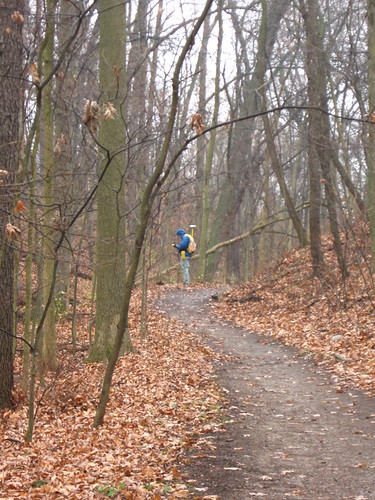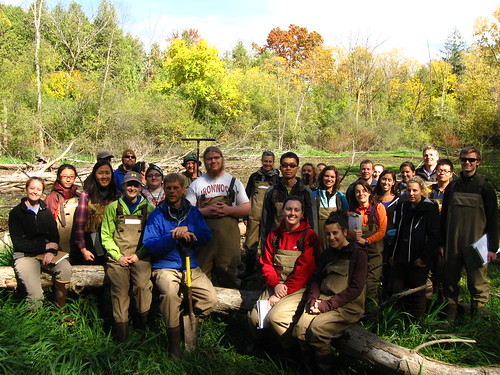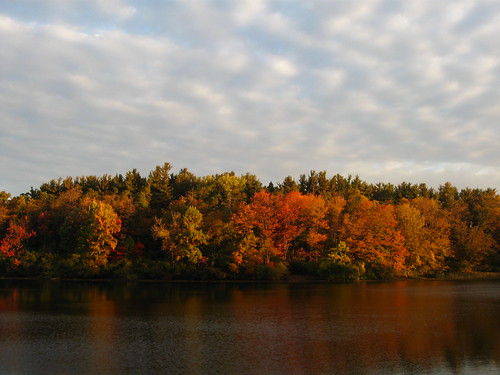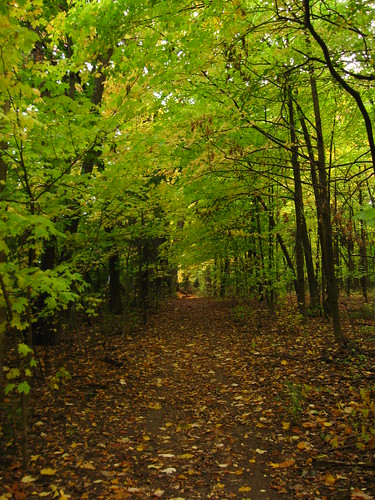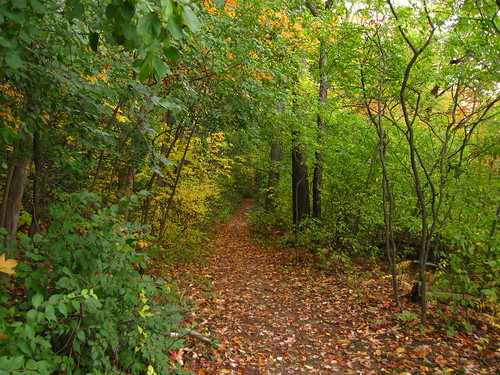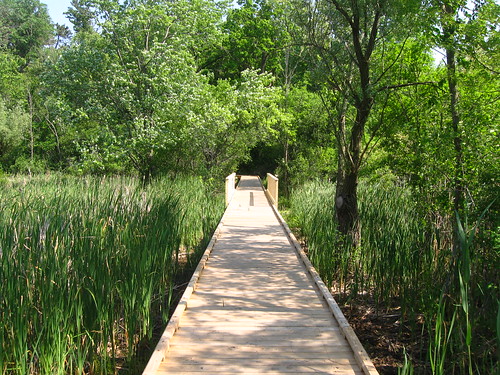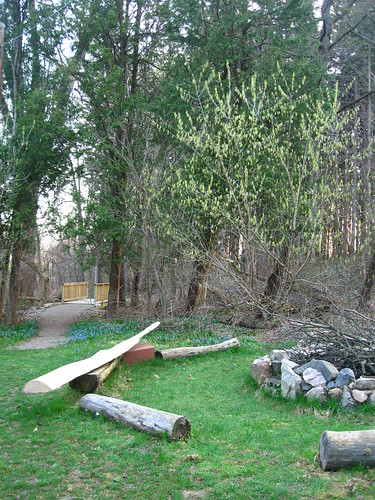As you walk around Saginaw Forest - or actually any area with trees - you might not have wondered where the trees actually came from. I mean, it was probably never a question that you asked. But do you really know where all that "stuff" that makes the tree actually came from?
Before you check out this video from Veritasium, stop for a moment and make a prediction.
Got it?
Okay, now click, "PLAY":
For all of you who don't have a background in biology, was your prediction correct?
So now that you know where all the mass of a tree comes from, you might have an additional appreciation for why forests (and also deforestation) is important when thinking about the future.
Use of the Forest
Public use of Saginaw Forest is encouraged. Rules for the public's use include (but are not limited to):
- No parking in front of the access gate.
- Public use hours are from 6am to 6pm only; no camping on the site!
- No vehicles or bicycles are permitted on the site except those for approved research and teaching use (bike parking available at the main gate).
- Dogs with owners are welcome to visit, but they must be on a leash. (Also see here.)
- Dog owners must carry out all pet waste; please bring your own doggie bag to do so.
- No cutting or collecting of plant material; no hunting or harming vertebrates (this includes no fishing).
- No smoking.
Monday, December 17, 2012
Saturday, December 15, 2012
Raking the trails
Much of the trails in Saginaw Forest have been raked - by yours truly.
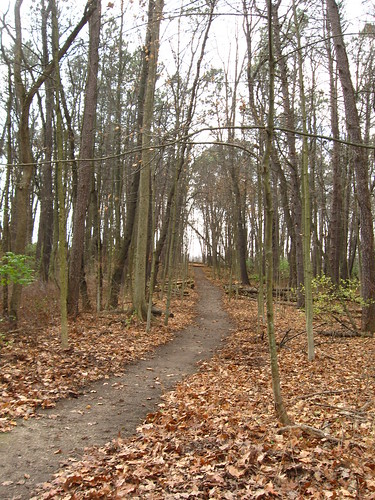
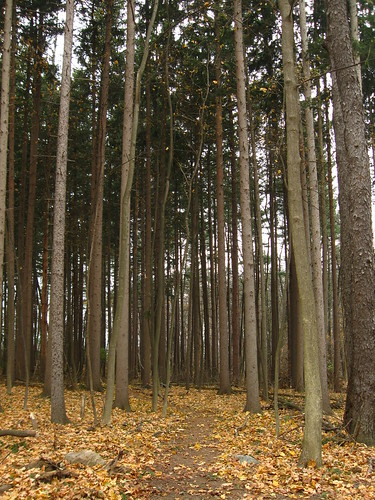
Why did I do all of this? After all, next year, it will all get covered again, right?
Well, each of the last few years, I've had to negotiate walking along the pathways in the springtime, with them in a treacherous semi-frozen, semi-slushed, semi-muddy mess. Over the year, the walking of the trails crushes the leaves, breaking them down. And then, when the snows come, the ground (and leaves and mashed leaves) gets saturated. When this starts to thaw, the leaves produce discontinuous layers of ice, frozen leaves, water, slosh, wet leaves, etc. In other words: a mess.
The idea is that - since most of the soil of the property is sand, and the majority of the paths are gravel laid atop this sand - if I rake the leaves, there will be greater amounts of infiltration in the spring. Furthermore, even in places where the leaf litter buildup and decomposition have accumulated a significant enough layer of soil, raking away the leaves will allow for this soil to be more easily washed away, revealing the gravel path below (thus improving the quality of the pathways - as pathways).
I even raked a trail out to Westview Way, so that it will be easy to stay off the untrodden ground (we don't like unnecessary soil compaction) while walking into the facility:


Why did I do all of this? After all, next year, it will all get covered again, right?
Well, each of the last few years, I've had to negotiate walking along the pathways in the springtime, with them in a treacherous semi-frozen, semi-slushed, semi-muddy mess. Over the year, the walking of the trails crushes the leaves, breaking them down. And then, when the snows come, the ground (and leaves and mashed leaves) gets saturated. When this starts to thaw, the leaves produce discontinuous layers of ice, frozen leaves, water, slosh, wet leaves, etc. In other words: a mess.
The idea is that - since most of the soil of the property is sand, and the majority of the paths are gravel laid atop this sand - if I rake the leaves, there will be greater amounts of infiltration in the spring. Furthermore, even in places where the leaf litter buildup and decomposition have accumulated a significant enough layer of soil, raking away the leaves will allow for this soil to be more easily washed away, revealing the gravel path below (thus improving the quality of the pathways - as pathways).
I even raked a trail out to Westview Way, so that it will be easy to stay off the untrodden ground (we don't like unnecessary soil compaction) while walking into the facility:
Friday, December 14, 2012
Surveying the creek
Saturday, December 8, 2012
They aren't the oldest trees in the world, but...
In reading through my news items for today, I came across an article describing the fragility old trees in a changing climate:
Still, it's something to think about when you're walking through the forest, recalling (in some deep recess of your mind) that you are walking through a forested landscape that - while not a "natural" forest - is in the range of 60-100+ years old. It's still a relatively "new" forest in that way, having not "matured" to be dominated by the climax community that we would have experienced way back in the early 1800s: a hardwood forest of oak, maple, and beech. It may also be sobering to recall that - thanks to climate change and the changed driving forces that our new and future climate have on the local ecology - Saginaw Forest will not be changing to resemble that 1800s forest of Southeast Michigan so much as a forest that would have been more typical of central Ohio.
In sum - and to bring it back to the topic of the paper - the century-plus old trees on the northern side of the property will likely die faster now than they would have if the climate hadn't changed, that those trees will also be more quickly releasing their stored carbon into the atmosphere, and that those reaches of the property are on a destined path toward a climax forest that would have been more recognizable around the Columbus, OH of 1800 than the Ann Arbor, MI of that same time.
A report by three of the world's leading ecologists in today's issue of the journal Science warns of an alarming increase in deathrates among trees 100-300 years old in many of the world's forests, woodlands, savannahs, farming areas and even in cities.The reason behind this increased rate of die-off among old trees? Well, it's not only because the trees are reaching the end of their lives (some trees can live for several centuries, after all), but because the environments in which these trees live are changing. And why is this happening? Well:
"According to one popular theory, trees get a double-whammy when the thermometer rises. "During the day, their photosynthesis shuts down when it gets too warm, and at night they use more energy because their metabolic rate increases, much as a reptile's would do when it gets warmer." With less energy being produced in warmer years and more being consumed just to survive, there is less energy available for growth. "This hypothesis, if correct, means tropical forests could shrink over time," Professor Laurance said. "The largest, oldest trees would progressively die off and tend not to be replaced. Alarmingly, this might trigger a positive feedback that could destabilize the climate: as older trees die, forests would release some of their stored carbon into the atmosphere, prompting a vicious circle of further warming, forest shrinkage and carbon emissions."In Saginaw Forest, we don't think of the trees as being particularly "old" - at least I doubt that many people think of Saginaw Forest as some sort of primeval wood, but it's important to remember that some of the trees on the property have joined the century club, having been planted waaay back in 1904. And these trees are dying off, although whether it's due to being planted too close or due to physiological exacerbations caused by climate stress (since many of these old Saginaw Forest trees are actually native to more northerly regions of the state), I can't say.
Still, it's something to think about when you're walking through the forest, recalling (in some deep recess of your mind) that you are walking through a forested landscape that - while not a "natural" forest - is in the range of 60-100+ years old. It's still a relatively "new" forest in that way, having not "matured" to be dominated by the climax community that we would have experienced way back in the early 1800s: a hardwood forest of oak, maple, and beech. It may also be sobering to recall that - thanks to climate change and the changed driving forces that our new and future climate have on the local ecology - Saginaw Forest will not be changing to resemble that 1800s forest of Southeast Michigan so much as a forest that would have been more typical of central Ohio.
In sum - and to bring it back to the topic of the paper - the century-plus old trees on the northern side of the property will likely die faster now than they would have if the climate hadn't changed, that those trees will also be more quickly releasing their stored carbon into the atmosphere, and that those reaches of the property are on a destined path toward a climax forest that would have been more recognizable around the Columbus, OH of 1800 than the Ann Arbor, MI of that same time.
Sunday, November 4, 2012
"I will never look at trees the same way again"
I'm a fan of the Veritasium channel on YouTube. I get to learn stuff about physics that I feel that I should have known already. This time, I knew the answer beforehand, but for people who didn't know exactly how trees can grow so tall, especially when you consider that you can't draw water up a straw for a distance of more than 10 meters. Since we know that trees can grow taller than 10 meters (~33 feet), and we know that trees have to have water climb all the way up their branches, then how do trees even exist?
Watch as a physicist has his mind blown:
... and now you know!
Watch as a physicist has his mind blown:
... and now you know!
Tuesday, October 30, 2012
Hail, but no snow.
A scattering, skittering, and pattering sound on the roof this morning as I woke up meant hail. And, yes, there was a lot of small hailstones that were hitting the cabin and building up along any nooks and crannies along the ground.
The winds had picked up a bucket and was pushing it around the yard, so into the barn that went.
Nothing other than some small branches down on the road out of the forest, at least at this point. Fingers remained crossed that it won't get more serious.
The winds had picked up a bucket and was pushing it around the yard, so into the barn that went.
Nothing other than some small branches down on the road out of the forest, at least at this point. Fingers remained crossed that it won't get more serious.
Monday, October 29, 2012
Intense winds (and potential for snow in the morning)
All of today and throughout tomorrow, there has been and will continue to be severe wind, mostly from the north, thanks to Hurricane Sandy hitting the East Coast. This is potentially worrisome, because the forest does not encounter very many winds from the north (let alone gusts), so there could be some trees down tomorrow. Luckily, the north of the cabin is the lawn, so it's unlikely that the wind will topple a tree onto the cabin from that direction. Still... the power could also go out.
In addition to all this, there is a possibility for snow!
Fingers crossed that nothing bad happens tonight, tomorrow, or for the rest of this storm.
In addition to all this, there is a possibility for snow!
Fingers crossed that nothing bad happens tonight, tomorrow, or for the rest of this storm.
Friday, October 26, 2012
Girl Scouts in Saginaw Forest
Last weekend, there were a number of girl scouts in Saginaw Forest. The following is from Erin Lane, from SNRE's Teaching and Inspiring Environmental Stewardship (TIES) program:
Two summers ago, the TIES program collaborated with the WISE (Women in Science and Engineering) program, and brought a number of female high school students to the forest to learn field research techniques. Hopefully, the TIES program will continue to be able to make use of the property as a teaching space for women and girls of all ages.
Thanks again to Erin and the U-M undergraduates who came out to make this even a great one for both the kids and parents who came out last weekend. It was fun to watch an enthusiastic group of kids, excited parents, and capable group coordinators.
The name of the event on October 21st was "Saginaw Forest Hiker", and it was an event in which girl scouts could practice hiking skills and play outdoor games to earn their "Hiker" Skill-Building Badge.
This was the first event that TIES has held for girl scouts at Saginaw Forest - the feedback from parents, scouts and troop leaders was outstanding! Therefore, we will aim to offer the event again next fall. The troops that attended were numbers 40280 and 60026. In addition, there was a "Juliette" (that's a girl scout term for a participant who does not belong to a troop) who also attended the event.
One of the parents sent a picture of her daughter, Audrey Hertz (she was the "Juliette"), who had just found a snake in the fallen leaves. The person in the photo holding the snake is a U-M undergrad who works for TIES, Veronica Kincaid.
Two summers ago, the TIES program collaborated with the WISE (Women in Science and Engineering) program, and brought a number of female high school students to the forest to learn field research techniques. Hopefully, the TIES program will continue to be able to make use of the property as a teaching space for women and girls of all ages.
Thanks again to Erin and the U-M undergraduates who came out to make this even a great one for both the kids and parents who came out last weekend. It was fun to watch an enthusiastic group of kids, excited parents, and capable group coordinators.
Massive leaf fall; more yet to come
I guess all the gusty winds on Thursday really helped shed leaves from branches, because the trees look far more barren than they did on Wednesday and my lawn is suddenly filled with lots of dried leaves (mostly oak it seems). The raking will likely continue for a few more weeks, though, since there are still a few trees that are cloaked with yellowing leaves. Soon, too, the buckthorn and the honeysuckle will be the only deciduous trees/shrubs that will have green leaves, making them a lot more easy to spot for potential removal. (In the spring, these plants are also one of the first woody plants to leaf out.)
Fall Photos
Some photos of the changing season:

The poison ivy are about to lose their leaves. (Still bad to touch them, though.)

The maples near the gate are slowly moving toward their color shifts.
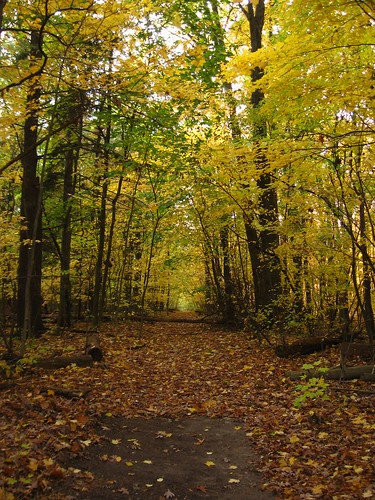
I decided to quit my raking of the path after I realized how much work was going to be falling from branches in the coming weeks. Still: they need to be raked so that they don't turn into muddy lanes come the spring.

Almost stepped on this guy as I was going back into the cabin. He wasn't any wider than my finger!

The poison ivy are about to lose their leaves. (Still bad to touch them, though.)

The maples near the gate are slowly moving toward their color shifts.

I decided to quit my raking of the path after I realized how much work was going to be falling from branches in the coming weeks. Still: they need to be raked so that they don't turn into muddy lanes come the spring.

Almost stepped on this guy as I was going back into the cabin. He wasn't any wider than my finger!
Monday, October 22, 2012
"No parking" has long been difficult for people to understand
Yesterday, I encountered a few vehicles that were parked at the gate, despite the plain signage that says that it is not legal to park there. For example, there was this SUV that was parked right in front of the "No parking" sign (just in case you had a difficult time to recognize the sign, what with all the colorful foliage, I've highlighted the sign):
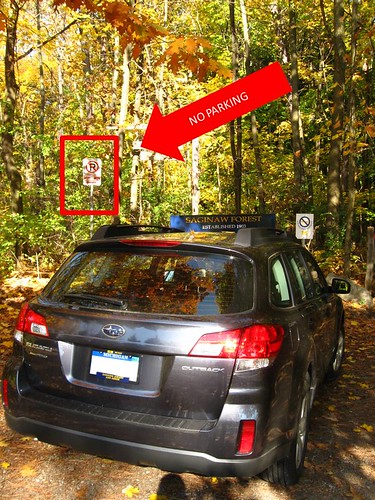
What's more, I decided to look up how many of the previous caretakers kvetched about no parking.
In 2007, in 1991, in 1989 (twice), and in 1987 In other words, it's been a consistent problem.
And I'm sure that the previous caretakers didn't note every single instance of having to report a vehicle (and not every caretaker wrote in the log book, either). I think that the number of people parking at the gate has diminished, but it is still higher than what would be the case if people followed the law.

What's more, I decided to look up how many of the previous caretakers kvetched about no parking.
In 2007, in 1991, in 1989 (twice), and in 1987 In other words, it's been a consistent problem.
And I'm sure that the previous caretakers didn't note every single instance of having to report a vehicle (and not every caretaker wrote in the log book, either). I think that the number of people parking at the gate has diminished, but it is still higher than what would be the case if people followed the law.
Wednesday, October 17, 2012
Fixed fence posts at front gate
A few weeks ago, I found that a couple of the fence posts at the front gate were pulled down (again).
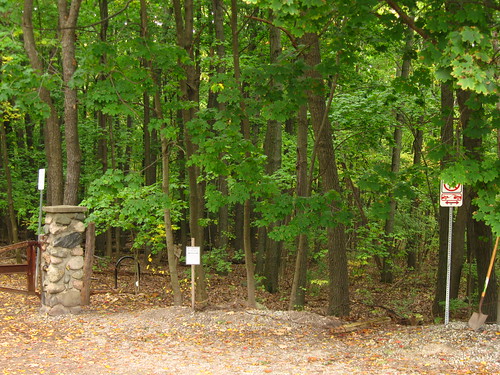
The other day, I went and redug the post holes, and returned the posts to their positions.

Still, I think that the front area should get a decent make-over and upgrade. New fence posts, new cable, fix the gate and the old gateposts, and - while we're at it - replace the fencing along Liberty Road.

The other day, I went and redug the post holes, and returned the posts to their positions.

Still, I think that the front area should get a decent make-over and upgrade. New fence posts, new cable, fix the gate and the old gateposts, and - while we're at it - replace the fencing along Liberty Road.
Photos from SNRE's annual Homecoming Campfire
Last Friday, October 12, 2012, was SNRE's annual Homecoming Campfire, and welcoming back of the class of 1962. It was a good turnout this year, with Beet Box providing the food, and the speed at which the food disappeared is a testament to how awesome it was! (It disappeared so fast that - between all the activities I was doing - I wasn't able to take a photo of the spread!)
Anyway, before the Campfire, there was some additional log-splitting that needed doing:
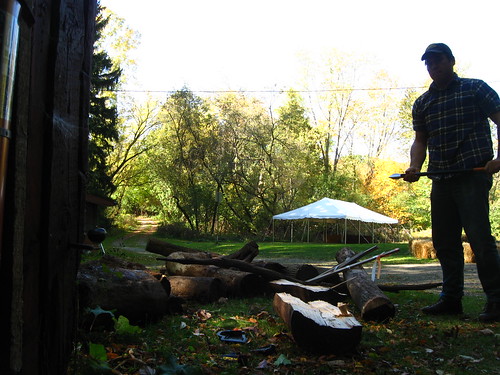
... and I really like that new Fiskars splitting axe that I purchased at the start of the month. It made short work of those ash logs. It's sharp, keeps an great edge, has a perfect wedge for splitting, is well balanced, and is not stupidly heavy.
Prep work also included moving the row boats to a different location:
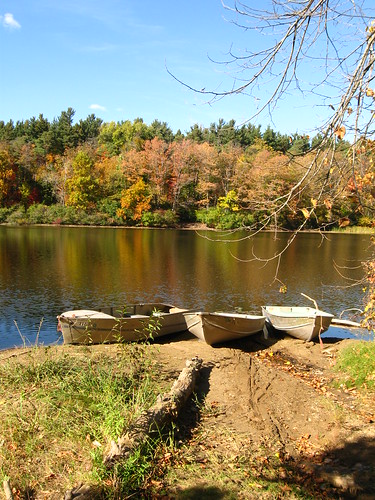
One can't have people taking pleasure rides in the middle of the night, right? And, also, with all the boats there, it makes it difficult to safely run the wader races:
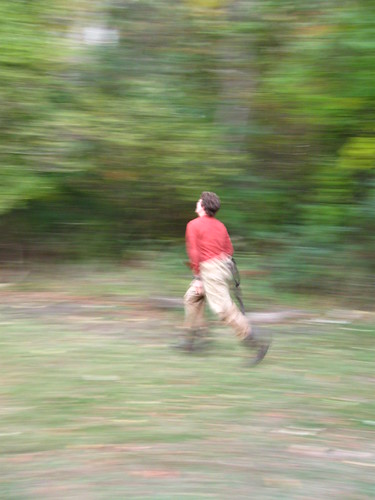
Happily, we were able to run the wader race early enough in the evening that we didn't have to do the log-sawing competition in the dark:

... looking back through my photos, I think that this was the first time in a number of years that the log sawing was done during daylight hours. Usually, it has been illuminated by the headlamps and flashlights of all the cheering SNREds.
It was a great honor of mine to also take the alumni of the class of 1962 on a tour of the forest; a place that they had come many times 50 years previous, when they were forestry students. They asked many interesting questions, were heartened to know that the property was still being used for research and teaching, were a little discouraged about the consequences of the lack of serious investment in the property, and generally curious about what changes I knew of that had happened between the time of their graduation and last Friday. What was meant to be a 40 minute tour of the lake trail turned into a discussion that was more than an hour long about many different aspects of the history and ecology of the forest. Hopefully, SNRE's alumni relations will help in trying to get these former students to recount some of their memories of the forest.
Anyway, before the Campfire, there was some additional log-splitting that needed doing:

... and I really like that new Fiskars splitting axe that I purchased at the start of the month. It made short work of those ash logs. It's sharp, keeps an great edge, has a perfect wedge for splitting, is well balanced, and is not stupidly heavy.
Prep work also included moving the row boats to a different location:

One can't have people taking pleasure rides in the middle of the night, right? And, also, with all the boats there, it makes it difficult to safely run the wader races:

Happily, we were able to run the wader race early enough in the evening that we didn't have to do the log-sawing competition in the dark:

... looking back through my photos, I think that this was the first time in a number of years that the log sawing was done during daylight hours. Usually, it has been illuminated by the headlamps and flashlights of all the cheering SNREds.
It was a great honor of mine to also take the alumni of the class of 1962 on a tour of the forest; a place that they had come many times 50 years previous, when they were forestry students. They asked many interesting questions, were heartened to know that the property was still being used for research and teaching, were a little discouraged about the consequences of the lack of serious investment in the property, and generally curious about what changes I knew of that had happened between the time of their graduation and last Friday. What was meant to be a 40 minute tour of the lake trail turned into a discussion that was more than an hour long about many different aspects of the history and ecology of the forest. Hopefully, SNRE's alumni relations will help in trying to get these former students to recount some of their memories of the forest.
Water collection for 1,4-dioxane sampling
On Monday and Tuesday, water collections were taken throughout Saginaw Forest as part of the yearly audit of 1,4-dioxane contamination levels throughout the property. There was obligatory surface water sample collecting at three locations on Third Sister Lake:

In addition, there was groundwater sample collection at the twelve on-site wells:


In addition, there was groundwater sample collection at the twelve on-site wells:

Just what is that flag barrier for?
Some people might have noticed that there has been a ribbon fence erected in the front yard.

This is to minimize the problems of desire paths. I'd prefer to not have a dirt path carved through the lawn.

This is to minimize the problems of desire paths. I'd prefer to not have a dirt path carved through the lawn.
Tuesday, October 16, 2012
SNREds in the forest
Friday, October 12, 2012
SNRE Campfire Tonight!
This will be the fourth campfire for which I will be the on-the-ground organizer (you know, because I'm the caretaker). The campfire is part of the University of Michigan's School of Natural Resources and Environment's Homecoming celebrations. We're expecting to have a handful of 1962 alumni at the event, in addition to the local alums who are interested in showing up and showing how things are done. Events like this always seem to gel at the last minute (much like a good souffle), but since tonight is the night, I haven't any photos from this year's campfire.
However, this is a photo from my first year as caretaker (2009). That year, the Campfire was on October 1, 2009, and - as you can see - the trees on the far side of the lake hadn't quite turned yet.
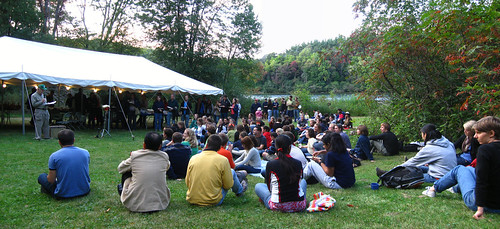
Hopefully, it will be a great Campfire event.
However, this is a photo from my first year as caretaker (2009). That year, the Campfire was on October 1, 2009, and - as you can see - the trees on the far side of the lake hadn't quite turned yet.

Hopefully, it will be a great Campfire event.
Wednesday, October 10, 2012
Peak fall colors
Why does mist rise from the lakes in the morning?
During the fall, there many morning when Third Sister Lake produces gouts of mist and steam:
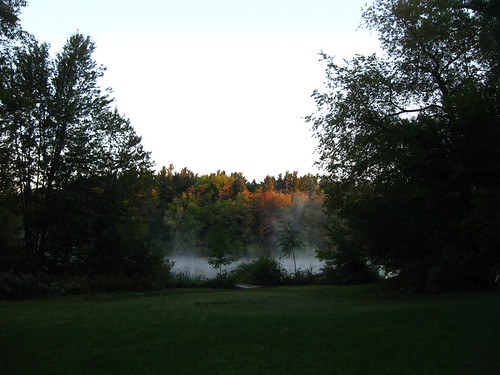
What's going on here? Obviously, the lake is not boiling, and - obviously - there isn't a general fog blanketing the entire forest, so why does the lake look like a pot on the stove? Well, it's due to many of the same principles of what happens when water boils in a pot on the stove, namely evaporation and condensation, but you have to think of these things in terms of heat energy and NOT in terms of water temperature alone.
In the case of boiling water on a stove, water is heated, causing evaporation; the gaseous water requires a certain amount of heat energy to maintain its gaseous state, and if the heat energy of the gaseous water falls below the condensation point, it turns back into liquid water, forming a fine mist. The mist increases in density as the amount of condensing water increases. This is why you see more and more steam rising from a pot of water as it reaches boiling point.
However, it's not only the temperature of the water that you have to consider when thinking about steam formation. In addition to the process of condensation described above, there is also the humidity to consider. In other words, the air itself can only "hold" a certain amount of gaseous water, and this capacity is determined by the temperature of the air; the higher the air temperature, the more water can be held as a gas. This is why there's a lot more steam seen above a pot boiling in very humid conditions than in very dry conditions (even when the air temperatures are identical).
In the case of misty lakes in the morning, all these processes are happening, just like in the example of the boiling pot, except the temperatures are far lower. Throughout the summer, the lake has absorbed and retained a large amount of heat energy in the top layer of the lake. At night -- especially on cloudless nights -- the heat energy in the air rises away from the surface and escapes this local system, thus bringing down the temperature. There is evaporation taking place in the lake, both day and night, thanks to the higher temperatures of the surface of the lake. However, unlike during the heat of the day, at night, since there is a lower temperature, there is less capacity for the air to hold on to gaseous water, and we can measure this as an increase in humidity. As the humidity rises to 100%, the air has a diminishing capacity to hold on to all the water that is evaporating -- due to the heat of the water in the lake -- and so the water almost immediately condenses into mist as it rises from the lake. In fact, if you heat a pot to the same temperature of the lake water, you would see steam flowing up from your pot, even though the water temperature is nowhere near boiling.
Once the sun's rays strike the surface of the water, the humidity is "burned away", in that the local temperature increases enough so that the humidity drops below 100%, thus allowing the air to once again absorb the evaporating water.
Of course, the reason why the lake effectively billows with steam during early fall mornings is due to the relatively large amount of heat stored in the lake combined with one or two significantly cold mornings. The photo above was taken on September 24, 2012, and if we look at the weather conditions measured at the Ann Arbor airport (about five miles away), we see that the overnight temperature dropped to freezing, and the humidity was near saturation. (Of course, this was in an open field, not above a lake, where the saturation would have been 100%.)
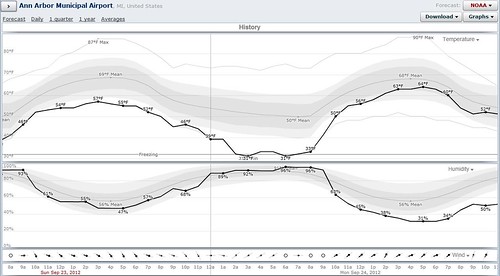
Yeah, okay, so this was a bit of a rambling post, but I hope that it helped you understand (if you didn't already) why so much mist rises off the lake on cool autumnal mornings. Of course, there is little reason to necessarily understand the why in order to appreciate the effect. In the end, fall is a veritable feast of sights, just like spring was one of smells, and summer one of sounds.

What's going on here? Obviously, the lake is not boiling, and - obviously - there isn't a general fog blanketing the entire forest, so why does the lake look like a pot on the stove? Well, it's due to many of the same principles of what happens when water boils in a pot on the stove, namely evaporation and condensation, but you have to think of these things in terms of heat energy and NOT in terms of water temperature alone.
In the case of boiling water on a stove, water is heated, causing evaporation; the gaseous water requires a certain amount of heat energy to maintain its gaseous state, and if the heat energy of the gaseous water falls below the condensation point, it turns back into liquid water, forming a fine mist. The mist increases in density as the amount of condensing water increases. This is why you see more and more steam rising from a pot of water as it reaches boiling point.
However, it's not only the temperature of the water that you have to consider when thinking about steam formation. In addition to the process of condensation described above, there is also the humidity to consider. In other words, the air itself can only "hold" a certain amount of gaseous water, and this capacity is determined by the temperature of the air; the higher the air temperature, the more water can be held as a gas. This is why there's a lot more steam seen above a pot boiling in very humid conditions than in very dry conditions (even when the air temperatures are identical).
In the case of misty lakes in the morning, all these processes are happening, just like in the example of the boiling pot, except the temperatures are far lower. Throughout the summer, the lake has absorbed and retained a large amount of heat energy in the top layer of the lake. At night -- especially on cloudless nights -- the heat energy in the air rises away from the surface and escapes this local system, thus bringing down the temperature. There is evaporation taking place in the lake, both day and night, thanks to the higher temperatures of the surface of the lake. However, unlike during the heat of the day, at night, since there is a lower temperature, there is less capacity for the air to hold on to gaseous water, and we can measure this as an increase in humidity. As the humidity rises to 100%, the air has a diminishing capacity to hold on to all the water that is evaporating -- due to the heat of the water in the lake -- and so the water almost immediately condenses into mist as it rises from the lake. In fact, if you heat a pot to the same temperature of the lake water, you would see steam flowing up from your pot, even though the water temperature is nowhere near boiling.
Once the sun's rays strike the surface of the water, the humidity is "burned away", in that the local temperature increases enough so that the humidity drops below 100%, thus allowing the air to once again absorb the evaporating water.
Of course, the reason why the lake effectively billows with steam during early fall mornings is due to the relatively large amount of heat stored in the lake combined with one or two significantly cold mornings. The photo above was taken on September 24, 2012, and if we look at the weather conditions measured at the Ann Arbor airport (about five miles away), we see that the overnight temperature dropped to freezing, and the humidity was near saturation. (Of course, this was in an open field, not above a lake, where the saturation would have been 100%.)

Yeah, okay, so this was a bit of a rambling post, but I hope that it helped you understand (if you didn't already) why so much mist rises off the lake on cool autumnal mornings. Of course, there is little reason to necessarily understand the why in order to appreciate the effect. In the end, fall is a veritable feast of sights, just like spring was one of smells, and summer one of sounds.
Sunday, October 7, 2012
Fall colors in the forest
Saturday, October 6, 2012
SNRE Campfire is coming...
This coming Friday, October 12, is the SNRE Campfire. This will be the 106th* celebration of the school out in Saginaw Forest, ever since the celebration of "field days" began in 1906.
In preparation for the event, I cleaned up the base of the fire-pit (removing the dirt and grass that had built up over the years),
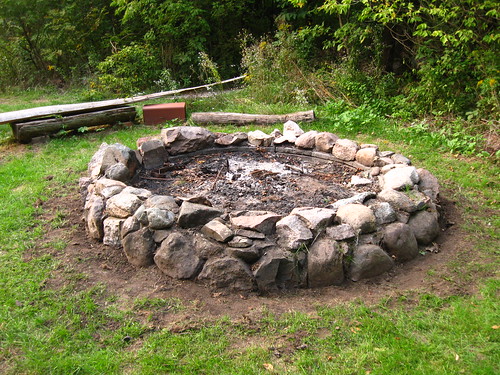
had a lot of the ash wood and pine wood that was lying around brought in,
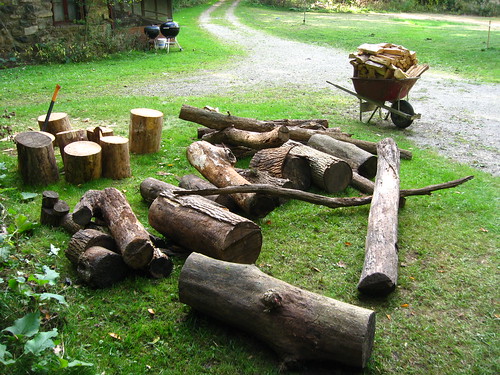
carried over a log for the cross-cut saw competition,

and chopped wood for the campfire.
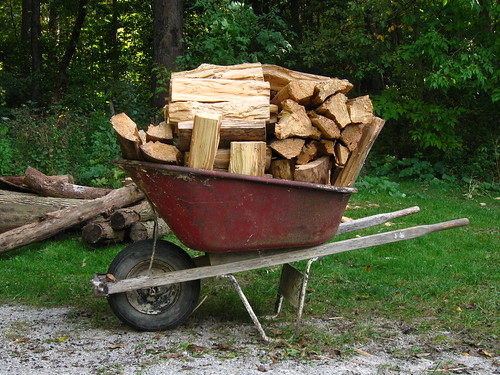
The deliveries of straw bales, pumpkins, event tent & tables, port-a-johns, and trash cans are due to come later in the week.
* I am making the assumption that the School of Forestry continued the tradition during the US involvement in the two World Wars (i.e., 1917-1918 and 1941-1945).
In preparation for the event, I cleaned up the base of the fire-pit (removing the dirt and grass that had built up over the years),

had a lot of the ash wood and pine wood that was lying around brought in,

carried over a log for the cross-cut saw competition,

and chopped wood for the campfire.

The deliveries of straw bales, pumpkins, event tent & tables, port-a-johns, and trash cans are due to come later in the week.
* I am making the assumption that the School of Forestry continued the tradition during the US involvement in the two World Wars (i.e., 1917-1918 and 1941-1945).
Saturday, September 29, 2012
Thanks to PitE student help in the forest
Today, I had a lot of help from PitE students who came out to the forest and - among other things - helped do some work out in the forest. Over the course of about an hour, these 20 students helped clip brush, haul wood, and clean some trails:
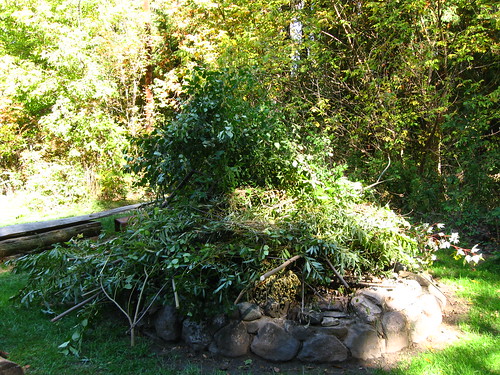


Thanks! ...and feel free to come out again to do some more work. ;)



Thanks! ...and feel free to come out again to do some more work. ;)
Thursday, September 27, 2012
Regional impacts due to Arctic melting: The future doesn't look anything like the past
Out of the University of Wisconsin - Madison, there is a brief on the potential future impacts of climate change on the region. (Well, the statements are about Wisconsin, but the impacted areas are definitely not going to stop at the Wisconsin state line.)
For Saginaw Forest, this will mean continued take-over by vines, continued lowering of the lake level, accelerated death of pine species, and rapid changes in the plant communities (as well as the insect, amphibians, reptiles, mammals, and birds that live in the forest). Furthermore, if lake levels get any lower than they are now, the near-shore habitat will be completely out of the water, severely limiting the available area for the fish currently in the lake to spawn, thus potentially causing a decline in the total number of fish in the lake.
... good times.
Vavrus, an expert on the arctic climate, says the dramatic melting trend is due to rising concentrations of greenhouse gases in the atmosphere warming the planet. He says natural variability may have accelerated the loss of ice in recent years, and he adds that the far north has physical characteristics that make it more sensitive to warming than other parts of the globe.What this means is that we can expect more weather patterns like what we saw this year: warmer winters, warmer springs, warmer summers, less rain on average, more rain in concentrated events, sudden cold snaps; you know: nothing like it used to be.
For one, he explains, snow and ice that normally cover the region reflect most incoming solar radiation back to space, but increased melting exposes land or ocean water that absorb more solar energy and accelerate any warming trend.
In addition, the lowest layer of the atmosphere in the Arctic is thin and prone to temperature inversions that hold warmer air near the ground, promoting even more melting as the region warms.
Vavrus says the Arctic is likely to continue to see pronounced downward trends in sea ice, snow cover, glacier extent, and permafrost. He says that will have major impacts on both natural ecosystems and human communities in the northernmost latitudes.
But the impacts of a warming Arctic could also be felt far beyond the region, including in the Midwest, according to research conducted by Vavrus and his colleague Jennifer Francis at Rutgers University published in the journal Geophysical Research Letters last spring.
"We believe that the winds aloft at the level of the jet stream will weaken and lead to slower-moving and 'wavier' atmospheric circulation patterns," he explains. "Such a change would favor more extreme weather events in middle latitudes, such as heat waves, droughts, floods, and—ironically—cold snaps."
For Saginaw Forest, this will mean continued take-over by vines, continued lowering of the lake level, accelerated death of pine species, and rapid changes in the plant communities (as well as the insect, amphibians, reptiles, mammals, and birds that live in the forest). Furthermore, if lake levels get any lower than they are now, the near-shore habitat will be completely out of the water, severely limiting the available area for the fish currently in the lake to spawn, thus potentially causing a decline in the total number of fish in the lake.
... good times.
Wednesday, September 19, 2012
Chipmunk sighting - stranger than you might think
This morning I saw a chipmunk. While a chipmunk in the forest might not seem like such a strange thing, there haven't been any ever since I noticed their disappearance back in 2009... thanks to the feral cat that was shacked up in the barn.
My thought is that the many chipmunks that I saw prior to the feral cat's presence were pretty much all killed by the momma cat to feed her litter. With the disappearance of the cat, the population of chipmunks were able to recover.
If we do some very basic back-of-envelope calculations, this makes a kind of sense:
Still, it's a further reminder of the predatory potential of house cats. One more reason why people should spay and neuter their cats: so feral cats won't have litters and end up killing small mammals and birds.
My thought is that the many chipmunks that I saw prior to the feral cat's presence were pretty much all killed by the momma cat to feed her litter. With the disappearance of the cat, the population of chipmunks were able to recover.
If we do some very basic back-of-envelope calculations, this makes a kind of sense:
- Chipmunks take a year to reach maturity, producing one or two litters each year (Feb-Apr and Jun-Aug).
- June 2009: Widespread death of chipmunks near the barn; assume no surviving females nor young, therefore no young litter from the June-August litters and no juveniles.
- Feb-Apr 2010: Cold average temperatures: assume unlikely that chipmunks in surrounding areas have new litters; death of juveniles likely high.
- Jun-Aug 2010: Production of first viable litters in 2010 in surrounding areas.
- Jun-Aug 2011: Production of second viable litters moving into the area around the barn.
- Feb-Apr 2012: Anomalously warm winter and spring create further litters in the surrounding areas.
- Jun-Aug 2012: Relatively high number of chipmunks in the area surrounding the barn.
- Sep 2012: Mast year for nuts mean that chipmunks are running around, looking for nuts
Still, it's a further reminder of the predatory potential of house cats. One more reason why people should spay and neuter their cats: so feral cats won't have litters and end up killing small mammals and birds.
Saturday, August 18, 2012
On this date in 1941: The second application of rotenone on Third Sister Lake
Time was that the humane treatment of animals didn't really extend to fish. As part of a bit of background reading to assess the possibility of conducting an updated fish survey of Third Sister Lake, I found only one article on the topic of fish in this lake, and it was published in 1942.
The very first sentence of the introduction reads:
We are relatively concerned about the presence of 1,4 dioxane in the groundwater, and the spills and their infiltration into the groundwater is cause for concern throughout the area affected, but it is worth noting that the wonderfully lovely looking Third Sister Lake was - at one point - the site for the deliberate complete and utter destruction of all fish (and all invertebrates, as well) in the lake. Of course, unlike 1,4 dioxane which is a very persistent molecule, rotenone loses almost all of its toxicity within one week.
Still, considering that the methodology is one that we wouldn't think of using today when conducting fish surveys, the 1941 survey did a few things, such as provide a good estimate of total fish biomass in Third Sister Lake as well as providing a date certain from when there were absolutely no fish in the lake.
BTW, rotenone continues to be used for fish collection and as a measure of last resort for fish management. Happily, though, rotenone won't be use in Third Sister Lake at any time soon.
The very first sentence of the introduction reads:
The complete removal of fish from Third Sister Lake was not carried out for the primary purpose of making a fish population analysis but rather as part of a general investigation on the existing relationship between the fish and fish-food organisms in this lake.The author continues by clinically describing the process:
The destruction of the fish population was accomplished by means of rotenone (Derris root) which was supplemented by netting-and angling during the 3 weeks previous to poisoning. The actual poisoning process and its effect on the fish and other organisms found in the lakes described by the authors elsewhere in this volume.In other words, they poisoned the lake and then collected the fish that floated up to the surface. The first time wasn't good enough to clear the lake, and so they did another application, but didn't include those fish in the survey. Oh, and by the way, no fish were seen until the summer of the following year; likely up-migration from the connecting stream.
The first poisoning operation was carried out on May 6, 1941, before the spawning season and before the aquatic vegetation was extensive enough to hamper the recovery of fish ... Because the first poisoning did not kill all the fish, a second application was made on August 18 and 19 when water temperatures were more favorable. Only a very few adult fish were recovered along with many thousand bluegill and pumpkinseed fry. These were not included in the population total. After that time, however no fish were seen in the lake until June, 1942,when a few long-eared sunfish entered the lake, presumably via the outlet during high water. We believe that the poisoning was 100 per cent effective in the removal of fish in August.
We are relatively concerned about the presence of 1,4 dioxane in the groundwater, and the spills and their infiltration into the groundwater is cause for concern throughout the area affected, but it is worth noting that the wonderfully lovely looking Third Sister Lake was - at one point - the site for the deliberate complete and utter destruction of all fish (and all invertebrates, as well) in the lake. Of course, unlike 1,4 dioxane which is a very persistent molecule, rotenone loses almost all of its toxicity within one week.
Still, considering that the methodology is one that we wouldn't think of using today when conducting fish surveys, the 1941 survey did a few things, such as provide a good estimate of total fish biomass in Third Sister Lake as well as providing a date certain from when there were absolutely no fish in the lake.
BTW, rotenone continues to be used for fish collection and as a measure of last resort for fish management. Happily, though, rotenone won't be use in Third Sister Lake at any time soon.
Thursday, August 9, 2012
Rain!
Ahhh... rain on the forest: lovely, lovely, lovely.
And it looks like we'll be getting rain throughout today and tonight.
It's not too surprising to say that this is something that the forest really needs.
And it looks like we'll be getting rain throughout today and tonight.
It's not too surprising to say that this is something that the forest really needs.
Friday, July 27, 2012
Summer drought: Comparison of years
Just like the comparison of "winter" this year and previous ones, it's interesting to look at the condition of this year's drought conditions. The front lawn area is where this year's drought is most evident. The brown lawn looks more like something one sees in California than what one would expect in southeastern Michigan.
From Thursday morning (July 25, 2012):
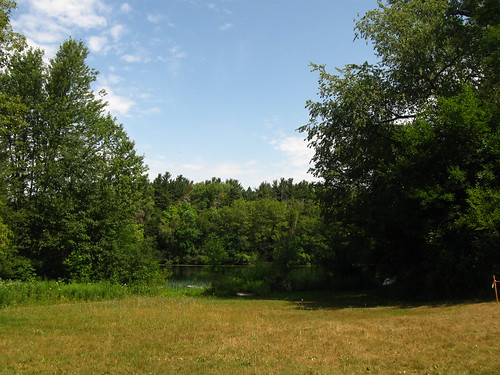
Compare it with July 23, 2011:
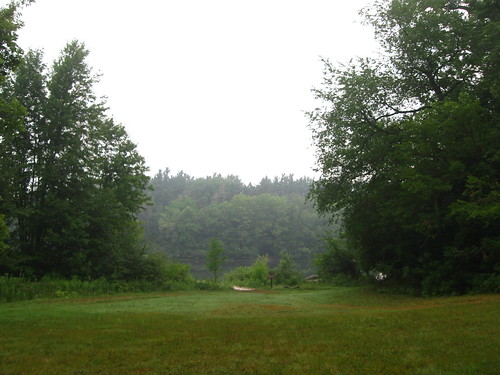
September 7, 2010 (couldn't find a photo from the end of July):
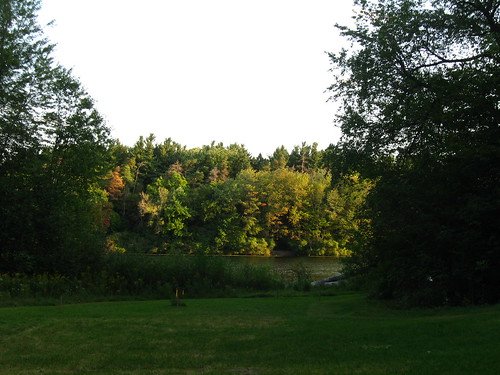
July 23, 2009:
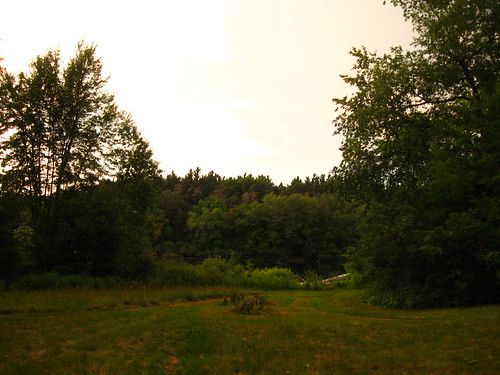
And although the lake appears to continue to be nice and blue and stable, it actually has continued to drop quite precipitously (considering that it's a spring fed lake and all). To wit:
On Thursday afternoon (July 25, 2012), you can see the matted bottom starting to show through the algal mat:
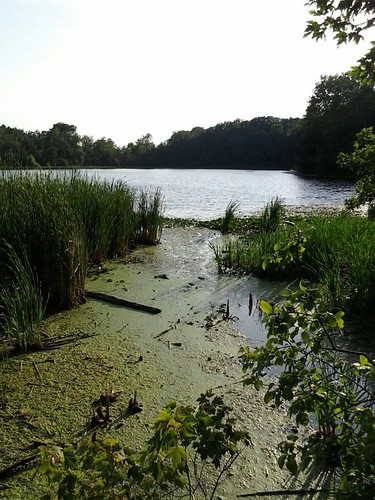
whereas two months ago (May 25, 2012) it was a channel deep enough for it to be a usable fish passage:

From Thursday morning (July 25, 2012):

Compare it with July 23, 2011:

September 7, 2010 (couldn't find a photo from the end of July):

July 23, 2009:

And although the lake appears to continue to be nice and blue and stable, it actually has continued to drop quite precipitously (considering that it's a spring fed lake and all). To wit:
On Thursday afternoon (July 25, 2012), you can see the matted bottom starting to show through the algal mat:

whereas two months ago (May 25, 2012) it was a channel deep enough for it to be a usable fish passage:

Thursday, July 26, 2012
Buckeyes growing in the forest
Living through this summer of far-hotter-than-normal days in Ann Arbor - home to the University of Michigan Wolverines - and working in environmental and natural resource management, I am thinking about the on-the-ground effects of climate change more than often. (Maybe more than is healthy.)
I hope for rain. I hope for cool winds. I hope for clouds even.
We get heavy sun that heats up asphalt, withers trees, and browns the grass. We get hot gusts of dry wind that buffet you into sweat-stained submission. We get few clouds, and those we get rarely carry rain for us.
It's the largest drought area ever declared, but some people are wondering if this is a forecast of things to come, or even the new normal. However, people from Mississippi River managers to Michigan cherry crop farmers to almost anyone paying attention in much of the country is recognizing that there is a massive drought happening and that weather has gone haywire (unless you happen to be Newton Leroy Gingrich).
And these are just the things that are happening right now. For University of Michigan fans, things could well get much worse.
According to research done in 2007 by Daniel McKenney and colleagues, the Ohio buckeye - which is the state tree of Ohio as well as the mascot to Ohio State University - will be shifting northward over the next 100 years. This means they will be shifting into Michigan, moving from its current distribution and possibly into Michigan (according to the CSIROmk35 A1B prediction model).
This will turn Michigan into the new "Buckeye State", and in Saginaw Forest, there are already many buckeye saplings that have been growing quite happily over the past number of years. Take a walk near the tree-tee-pee and see for yourself. (Here's the Ohio DNR's handy identification page.)
Will this growth get a lot of Michigan (and Michigan State) fans quite angry about the whole thing, and maybe start to think of climate change as something real? Yes, it's a strange way to introduce people to the effects of climate change, but many people have visceral attachments to sports, and for many people this includes university sports (even if they never attended that particular university).
What might make this an even greater blow for University of Michigan fans is that the last known wolverine living in the state died in 2011. With the local extirpation of the wolverine - the UofM mascot - and the encroachment of their largest rival's mascot onto home territory, could there be some sort of climate change education and action that come out of this? True, it was tried back in 2008, when the implications of McKenney's paper became recognized, but maybe the time is ripe again?
While part of this is written as tongue-in-cheek, another part of me is trying to think of ways to get people latched onto simple fact that climate change is not just happening right now, but has been happening for decades already; that the time to act is not tomorrow, but yesterday; and that the fact we haven't done a lot is only going to require us to work all the harder down the line.
I hope for rain. I hope for cool winds. I hope for clouds even.
We get heavy sun that heats up asphalt, withers trees, and browns the grass. We get hot gusts of dry wind that buffet you into sweat-stained submission. We get few clouds, and those we get rarely carry rain for us.
It's the largest drought area ever declared, but some people are wondering if this is a forecast of things to come, or even the new normal. However, people from Mississippi River managers to Michigan cherry crop farmers to almost anyone paying attention in much of the country is recognizing that there is a massive drought happening and that weather has gone haywire (unless you happen to be Newton Leroy Gingrich).
And these are just the things that are happening right now. For University of Michigan fans, things could well get much worse.
According to research done in 2007 by Daniel McKenney and colleagues, the Ohio buckeye - which is the state tree of Ohio as well as the mascot to Ohio State University - will be shifting northward over the next 100 years. This means they will be shifting into Michigan, moving from its current distribution and possibly into Michigan (according to the CSIROmk35 A1B prediction model).
This will turn Michigan into the new "Buckeye State", and in Saginaw Forest, there are already many buckeye saplings that have been growing quite happily over the past number of years. Take a walk near the tree-tee-pee and see for yourself. (Here's the Ohio DNR's handy identification page.)
Will this growth get a lot of Michigan (and Michigan State) fans quite angry about the whole thing, and maybe start to think of climate change as something real? Yes, it's a strange way to introduce people to the effects of climate change, but many people have visceral attachments to sports, and for many people this includes university sports (even if they never attended that particular university).
What might make this an even greater blow for University of Michigan fans is that the last known wolverine living in the state died in 2011. With the local extirpation of the wolverine - the UofM mascot - and the encroachment of their largest rival's mascot onto home territory, could there be some sort of climate change education and action that come out of this? True, it was tried back in 2008, when the implications of McKenney's paper became recognized, but maybe the time is ripe again?
While part of this is written as tongue-in-cheek, another part of me is trying to think of ways to get people latched onto simple fact that climate change is not just happening right now, but has been happening for decades already; that the time to act is not tomorrow, but yesterday; and that the fact we haven't done a lot is only going to require us to work all the harder down the line.
Wednesday, July 18, 2012
Unexpected cool morning
The morning is unexpectedly cool. After reaching 100F in town yesterday, and having an expected low temp of only 75F, I wake up to quite comfortable temperatures. The windows are now open and I'm attempting to pull in as much cool air as possible.
Hopefully, the weather won't get too hot today.
Hopefully, the weather won't get too hot today.
Tuesday, July 17, 2012
Warming temperatures leading to additional lake complications?
This past winter, Third Sister Lake didn't get a complete freeze, and it was possible, as the spring approached, to see algae growing in some of the ice. In March, while we were experiencing temperatures normally part of June weather, I wrote about some of the possible impacts that such weather might bring if they become the norm. I also wrote about some of the possible impacts to Third Sister Lake that such warming might bring.
Well, add to all that one more impact brought on by warming: decreased lake turnover. In a new paper out in the journal Climate Change, Swiss scientists have shown how increased warming in Swiss lakes have decreased lake turnover, and this has brought about increased levels of Burgundy blood algae.
The paper's abstract states:
Well, add to all that one more impact brought on by warming: decreased lake turnover. In a new paper out in the journal Climate Change, Swiss scientists have shown how increased warming in Swiss lakes have decreased lake turnover, and this has brought about increased levels of Burgundy blood algae.
The paper's abstract states:
Anthropogenic-induced changes in nutrient ratios have increased the susceptibility of large temperate lakes to several effects of rising air temperatures and the resulting heating of water bodies1. First, warming leads to stronger thermal stratification, thus impeding natural complete water turnover (holomixis), which compensates for oxygen deficits in the deep zones2, 3. Second, increased water temperatures and nutrient concentrations can directly favour the growth of harmful algae4, 5, 6. Thus, lake-restoration programmes have focused on reducing nutrients to limit toxic algal blooms7. Here we present evidence that the ubiquitous8, 9, 10 harmful cyanobacterium Planktothrix rubescens has become the dominant species in a large lake during the past four decades, although the phosphorus content of the ecosystem decreased fivefold. However, the nitrogen input was not diminished concomitantly, favouring this non-N2-fixing cyanobacterium owing to increased N:P ratios10. P. rubescens contains gas vesicles that allow for buoyancy to accumulate within the depth of optimal irradiance11. As the toxic cyanobacterium has low consumption by predators12, water turnover represents the main mechanism of seasonal population control. Thus, unidirectional lake-restoration measures13 in parallel with recurrent absence of holomixis owing to lake warming may lead to similar undesired effects that have formerly emerged from fertilization.This type of impact is problematic for Third Sister Lake, not because of Planktothrix (or because of other cyanobacteria, at least to my knowledge), but because Third Sister Lake is already a lake that doesn't completely turn over. From a 2001 paper by Bridgeman et al., the finding of lake stability (i.e., the resistance to turnover) in Third Sister Lake was that:
Salt-laden water entering Third Sister Lake [during the winter] from [the business lots to the southeast] could eventually lead to the formation of a chemocline. Large vertical gradients of salinity may potentially prolong stratification or altogether prevent mixing. ... If Third Sister Lake follows a similar pattern [to First and Second Sister Lakes], the contribution of a chloride gradient to stability would reach a maximum in March or April ... and the lake ... will remain [thermally stratified] until mid-November.The paper also reported that - due to forest growth from 1904 - Third Sister Lake didn't fully turn over in the spring (i.e., following ice-out), even back in 1986. The authors of the 2001 paper concluded that:
Given that the lake is now more sheltered [than in earlier decades] and may require about 60% more wind energy to overcome a chlorine gradient, complete spring mixing, which was a common event at least into the 1940s and occurred occasionally until the early 1980s, is now probably rare.And it's likely to remain rare if increased temperatures become the norm. (That is, unless a significant number of trees fall down, thus increasing the lake's wind exposure.)
Are vines growing faster?
Walking through Saginaw Forest this summer, I have noticed far more vine growth than I recall there being in previous years. Is this just my imagination? Confirmation bias? Or could it have something to do with the really warm winter that we had? (Too, could it have something to do with the differential rates of growth between vines and trees?)
What we know for sure is that the winter of 2011/2012 was a really warm one and March, May and June have been uncharacteristically warm, as well. There has also been less rainfall than usual.
Now, what I'm guessing at is that, since vines require less resources to maintain themselves and grow compared to trees, it seems possible to me that vines have been able to quickly take advantage of the warm spring and start their growth while also being able to continue growing during these more parched months. However, this is just a guess on my part.
What I know is that there are a lot of trees with vines growing on them; the vines themselves are very dense, and there's a lot of poison ivy, too. This radically warm winter, spring, and summer seem to correspond with the basic message of a 2006 paper by Mohan et al. Their abstract reads, in part:
What we know for sure is that the winter of 2011/2012 was a really warm one and March, May and June have been uncharacteristically warm, as well. There has also been less rainfall than usual.
Now, what I'm guessing at is that, since vines require less resources to maintain themselves and grow compared to trees, it seems possible to me that vines have been able to quickly take advantage of the warm spring and start their growth while also being able to continue growing during these more parched months. However, this is just a guess on my part.
What I know is that there are a lot of trees with vines growing on them; the vines themselves are very dense, and there's a lot of poison ivy, too. This radically warm winter, spring, and summer seem to correspond with the basic message of a 2006 paper by Mohan et al. Their abstract reads, in part:
Contact with poison ivy (Toxicodendron radicans) is one of the most widely reported ailments at poison centers in the United States, and this plant has been introduced throughout the world, where it occurs with other allergenic members of the cashew family (Anacardiaceae). ... Rising CO2 is potentially responsible for the increased vine abundance that is inhibiting forest regeneration and increasing tree mortality around the world. In this 6-year study at the Duke University Free-Air CO2 Enrichment experiment, we show that elevated atmospheric CO2 in an intact forest ecosystem increases photosynthesis, water use efficiency, growth, and population biomass of poison ivy. The CO2 growth stimulation exceeds that of most other woody species.We heard news a few months back that the atmospheric concentration of CO2 has increased past 400ppm, which doesn't correspond to the elevated CO2 chambers of Motan et al's study, but as the Motan paper discusses previous studies on increased CO2 and vine growth:
So, poison ivy is expected to be more abundant and a greater lover of the high CO2 future than trees. And this is likely also a cause for the increase vine abundance in general.
With an increase in CO2 concentration and a corresponding increase in photosynthesis, vines can allocate more photosynthate to additional photosynthetic tissue, because of a low allocation to support tissue relative to other woody growth forms (13, 14, 18, 19). Increasing abundance of woody vines is causing increased tree mortality and reduced tree regeneration in forests around the globe (18, 20–23), potentially resulting in shifts in community composition that may impact carbon cycling and biodiversity (23). Although it is unclear how elevated CO2 will affect the growth of vines in forest environments, the contemporary increase in woody vine abundance may be the result of rising atmospheric CO2 concentrations (19, 23).The Motan et al paper doesn't discuss the impacts of warmer winters, springs, and summers on poison ivy growth (nor on the growth of other vine species). However, I am going to guess that a large part of the vine growth this year is likely due to the ever increasing CO2 levels and have been exacerbated this year by the unnaturally warm seasons.
Monday, July 9, 2012
Morning temps cooled off
The morning temperatures have really cooled off these past two mornings. Yesterday it was enough to bring the inside-cabin temperature all the way back down to 70F and today I woke up to an inside temperature of 66F, and - walking outside - I was greeted with what had to be in the low 60s or high 50s.
Too, the rising sun was showing off the steam rising from the lake, and as I walked down to the dock, I startled a great blue heron that jumped out of its standing place and slowly sailed to the far side of Third Sister, squawk-honking all the way; no doubt annoyed at being disturbed.
Nice morning.
Too, the rising sun was showing off the steam rising from the lake, and as I walked down to the dock, I startled a great blue heron that jumped out of its standing place and slowly sailed to the far side of Third Sister, squawk-honking all the way; no doubt annoyed at being disturbed.
Nice morning.
Saturday, July 7, 2012
Cabin climate
As mentioned previously, the cabin does not have an A/C system, and these past days of record and near-record heat has meant a challenge in keeping the inside from being like a sauna. Thankfully, the cabin is almost entirely shaded and I don't use the stovetop very much nor use many heat-producing items (i.e., few appliances and no incandescent bulbs). This means that - combined with the thick stone walls - the cabin only slowly gains heat, even in this summer weather.
To wit, since yesterday morning (when I last had opened the windows), the inside-cabin temperature has gone up from 75F to 83F, slowly climbing through yesterday's 101F and today's 97F. Thanks to the dehumidifier and fans, the inside humidity stays below 65%. However, I've had to empty out at least 4 gallons of water from the dehumidifier over the past 36 hours!
Happily, I'll be able to cool off the cabin tonight, since the overnight low will doubtless be lower than 83F, and it's expected to be as low as 65F. Phew, I was getting to the point when I was starting to think about purchasing an A/C unit...
Cold showers also help.
UPDATE (2012-July-08): Thanks to the cool temperatures of last night, the inside cabin temperature has come down to 70F. Based on the forecast for tonight, I might even be able to get the temperature down to 60F; a good way to start a week that is expected to climb slowly back up to 100F by next weekend by some forecast.
To wit, since yesterday morning (when I last had opened the windows), the inside-cabin temperature has gone up from 75F to 83F, slowly climbing through yesterday's 101F and today's 97F. Thanks to the dehumidifier and fans, the inside humidity stays below 65%. However, I've had to empty out at least 4 gallons of water from the dehumidifier over the past 36 hours!
Happily, I'll be able to cool off the cabin tonight, since the overnight low will doubtless be lower than 83F, and it's expected to be as low as 65F. Phew, I was getting to the point when I was starting to think about purchasing an A/C unit...
Cold showers also help.
UPDATE (2012-July-08): Thanks to the cool temperatures of last night, the inside cabin temperature has come down to 70F. Based on the forecast for tonight, I might even be able to get the temperature down to 60F; a good way to start a week that is expected to climb slowly back up to 100F by next weekend by some forecast.
Friday, July 6, 2012
Swelteringly hot in the forest... implications for a future Saginaw Forest?
Although the rains of the hard rains of the past two days have helped (a very little bit) with the longer-term lack of rain, the constant heat isn't helping with temperatures in the forest.
Today, when walking outside, I felt the steaming heat of the outside. Humidity seemed to be at or near 100% and the temperatures were pushing 90F at 11am; what happened to the low 70s from just three hours earlier?
Many scientists are saying that this summer is a glimpse of a world under conditions of global warming. If this is what a 2C rise in global temperature means in Ann Arbor, we'll have much to look forward to in Saginaw Forest, including:
* more deer flies and horse flies
* more vine growth (including poison ivy)
* fewer raspberries due to a comparative lack of water
* a smaller Third Sister Lake (which is already at its lowest level that I remember), which means little use of the dock that was put there and - due to the steep grade of the lake - less and less suitable nesting habitat for the fishes that are already in there
* a lowered water table due to a combination of increased evapotranspiration, diminished recharge, and diminished retention capacity
* more tree death, since the existing trees may suffer from heat stress and a lack of water due to a lowered water table
* a different tree mix - including many more Ohio and Indiana species - that is more suited to hotter summers
In other words, a future Saginaw Forest is likely to be far more sparse in tree cover, will have - in upland areas - younger trees that are better adapted to warmer and drier conditions, and will have a smaller lake with far fewer fish. The lawn in front of the cabin may well be dry throughout the summer months, and the raspberry canes will be producing smaller and more sour berries.
Today, when walking outside, I felt the steaming heat of the outside. Humidity seemed to be at or near 100% and the temperatures were pushing 90F at 11am; what happened to the low 70s from just three hours earlier?
Many scientists are saying that this summer is a glimpse of a world under conditions of global warming. If this is what a 2C rise in global temperature means in Ann Arbor, we'll have much to look forward to in Saginaw Forest, including:
* more deer flies and horse flies
* more vine growth (including poison ivy)
* fewer raspberries due to a comparative lack of water
* a smaller Third Sister Lake (which is already at its lowest level that I remember), which means little use of the dock that was put there and - due to the steep grade of the lake - less and less suitable nesting habitat for the fishes that are already in there
* a lowered water table due to a combination of increased evapotranspiration, diminished recharge, and diminished retention capacity
* more tree death, since the existing trees may suffer from heat stress and a lack of water due to a lowered water table
* a different tree mix - including many more Ohio and Indiana species - that is more suited to hotter summers
In other words, a future Saginaw Forest is likely to be far more sparse in tree cover, will have - in upland areas - younger trees that are better adapted to warmer and drier conditions, and will have a smaller lake with far fewer fish. The lawn in front of the cabin may well be dry throughout the summer months, and the raspberry canes will be producing smaller and more sour berries.
Thursday, June 28, 2012
Weather not helping
It's been a scorcher today, getting up to 100F in town today (likely a little less than that out in the forest). However, we've also not had any rain for a while, and the grass and some of the trees are not growing well...
When's the rain going to come?
And when the rain comes, could it please be a long, slow shower, and not a flash flood?
When's the rain going to come?
And when the rain comes, could it please be a long, slow shower, and not a flash flood?
Sunday, June 24, 2012
Cleared brush & saw raccoons
This morning, we cleared some of the brush that had grown up west of the dock so that we could put one of the small research vessels into Third Sister Lake. I can also now see the end of the dock from the cabin.
Much of the work was facilitated by the use of the chainsaw, well-sharpened loppers, a hard-tined rake, and two masters' students who will be using the lake to calibrate their equipment for their main summer research sites within the Muskegon River watershed.
Also, when conducting my evening rounds, I heard some grunting and scrabbling in the trees near the frog pond. As I looked up, I saw two masked faces staring back at me, and soon saw a third raccoon clambering up yet another tree. I guess the pickings along the road - the pickings of civilization - are a little bit dried up at present. Maybe they know that the garbage won't be put out until Tuesday night and so are foraging for more "evolutionarily traditional" food down by the frog pond. Hopefully the deer flies aren't getting to them as bad; the buggers were flying all around my head as I did my rounds.
Much of the work was facilitated by the use of the chainsaw, well-sharpened loppers, a hard-tined rake, and two masters' students who will be using the lake to calibrate their equipment for their main summer research sites within the Muskegon River watershed.
Also, when conducting my evening rounds, I heard some grunting and scrabbling in the trees near the frog pond. As I looked up, I saw two masked faces staring back at me, and soon saw a third raccoon clambering up yet another tree. I guess the pickings along the road - the pickings of civilization - are a little bit dried up at present. Maybe they know that the garbage won't be put out until Tuesday night and so are foraging for more "evolutionarily traditional" food down by the frog pond. Hopefully the deer flies aren't getting to them as bad; the buggers were flying all around my head as I did my rounds.
Saturday, June 23, 2012
A reminder about dog-leashing
I had written about this before, but apparently, some people don't recognize that the sign means that they are supposed to have their dogs on-leash. (Sorry, but if your dog is a member of the species Canis lupus familiaris, it has to be on leash.)
There is one location where - based upon mutual agreement - dogs may be off-leash: the opening on the north side of Third Sister Lake. Other than that, people must follow the rule of "all dogs must be on leashes".
It's that simple.
There is one location where - based upon mutual agreement - dogs may be off-leash: the opening on the north side of Third Sister Lake. Other than that, people must follow the rule of "all dogs must be on leashes".
It's that simple.
Friday, June 22, 2012
Brief description of Third Sister Lake
Although there have been many studies in Third Sister Lake, although I provided an initial description of Third Sister Lake, and although there have been descriptions of the history of the forest, little on this site has included much discussion of the history of the lake and of the inputs to the lake.
The following is taken from Hammer & Stoermer (1997), and any use of the following description in any publication must provide proper citation of their paper:
Bibliography:
The following is taken from Hammer & Stoermer (1997), and any use of the following description in any publication must provide proper citation of their paper:
Third Sister Lake (42°17' N., 83°48' W.) is located approximately three miles west of Ann Arbor in the Saginaw Forest of Scio Township, Michigan (Figure 1). This small kettle lake likely formed during the retreat of the Wisconsin glacier, which created a terminal moraine in southern Michigan (Reed, 1902). Mature conifer plantations and hardwood stands of Saginaw Forest shelter Third Sister Lake. Although the lake stratifies in the summer, spring mixing does not occur every year (Lehman & Naumoski, 1986). The present maximum depth is 17.0 m, and the surface area about 3.8 ha. A small intermittent stream enters the lake on the south shore and a single outflow on the southwest shore drains through a small marsh (Figure 1) to the Huron River.
Although Saginaw Forest surrounds Third Sister Lake on a 32 ha tract, significant construction has occurred in the watershed since the 1960s. Agricultural activities originally occupied the entire area east of Saginaw Forest. Currently, this adjacent property is subdivided into several small plots (Wojcik, 1993, personal communication) where industrial and commercial construction has occurred from 1963 to the present (Figure 1). Contamination of Third Sister Lake and local groundwater with 1,4-dioxane was revealed in the 1980s following leakage from an unlined, oxidation lagoon on Gelman Sciences, Inc. property bordering the lake (Brode&Minning, 1988). The most recent project in the adjacent lot, initiated in 1987, included retention pond construction with an outflow that transports stormwater from this nearby property into the inflow stream bed in Saginaw Forest. Ultimately this stormwater reaches Third Sister Lake 300 m downstream. Although erosion barriers were erected in the stream bed on university property, these barriers have since been undercut and subverted by stream flow, creating a gully with steep banks of unconsolidated soil. (Hammer & Stoermer, 1997, pp. 438-439)
Bibliography:
- Hammer, Brian K.; Stoermer, Eugene F.; (1997). "Diatom-based interpretation of sediment banding in an urbanized lake." Journal of Paleolimnology 17 (4): 437-449. http://hdl.handle.net/2027.42/43079
Plant lists for Saginaw Forest and Stinchfield Woods
Ever been wandering around Saginaw Forest (or Stinchfield Woods) and wonder, "What's that plant over there?"
The School of Natural Resources & Environment, as part of a multi-part project about the properties it manages, has compiled a plant list (along with photos) for Saginaw Forest and Stinchfield Woods, covering all the tree and shrub species (along with a few non-woody plants).
Strangely, it doesn't have an entry for the Murray birch.
Source:
The School of Natural Resources & Environment, as part of a multi-part project about the properties it manages, has compiled a plant list (along with photos) for Saginaw Forest and Stinchfield Woods, covering all the tree and shrub species (along with a few non-woody plants).
Strangely, it doesn't have an entry for the Murray birch.
Source:
- Gentile, Michela; Bergen, Kathleen; Tyrrell, Gerald (2012) Plant List for Saginaw Forest and Stinchfield Woods (http://hdl.handle.net/2027.42/90971)
Thursday, June 21, 2012
A 1961 description of the plantings
Doing a search for "Saginaw Forest" on the University of Michigan Library's DeepBlue server came up with several university documents about the property, including this one from 1961 that discusses the history and the plantings in the property:
A Guide to Saginaw Forest (1961)
A pdf is available for public download at that site. The document also contains a map of the three near-Ann Arbor properties managed by SNRE (Saginaw Forest, Newcomb Tract, and Stinchfield Woods) as well as an original plantings map of Saginaw Forest.
A Guide to Saginaw Forest (1961)
A pdf is available for public download at that site. The document also contains a map of the three near-Ann Arbor properties managed by SNRE (Saginaw Forest, Newcomb Tract, and Stinchfield Woods) as well as an original plantings map of Saginaw Forest.
Wednesday, June 20, 2012
Happy Summer Solstice!
Today is the 1st Day of Summer, and it feels like it's been summer for a while already.
Vines of all types have grown like crazy this year, including Virginia creeper, poison ivy, and grape vine. If we keep having such mild winters and warm springs, we'll likely have even more explosive vine growth, and the forest will turn more into a vine land.
Vines of all types have grown like crazy this year, including Virginia creeper, poison ivy, and grape vine. If we keep having such mild winters and warm springs, we'll likely have even more explosive vine growth, and the forest will turn more into a vine land.
Saturday, May 26, 2012
A rainy weekend, huh?
Well, that's a bit unexpected: rain for the long Memorial Day
weekend. I woke up to the sounds of distant thunder and then walked
outside (to take my daily photo) and... rain, rain, rain, rain, RAIN! Okay, it's not like monsoon-rain in quantity, but it does look like there will be more rain throughout the next two days.
The forest needs it, what with it being in the peak of bloom.
The forest needs it, what with it being in the peak of bloom.
Friday, May 25, 2012
Handrail installed on portion of boardwalk
Wednesday, May 23, 2012
Shower drain fixed!
Woot! The contractors came out today to fix the shower drain. First they had to find the blame thing, and - after digging down about three feet in a rough estimate of where it would be, they found the line. After cutting out a piece, it was pretty obvious that the drain problem was due to ... [drum roll] ... lime buildup. They ran a jetter along a pencil-line (i.e., a thinner line), because it was needed to enter a 1-1/2" pipe.
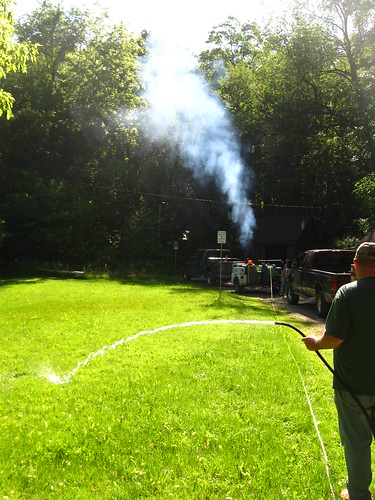
After jetting out the calcium build-up, the pipe was cleaned out, and all that was needed was a coupling to repair the cut section, and then I had a perfectly draining shower.

Luckily, we now know where the line is located (and a good idea where the drainage cistern is located, too), which will mean that it will make it easier to take care of similar problems that may arise in the future.

After jetting out the calcium build-up, the pipe was cleaned out, and all that was needed was a coupling to repair the cut section, and then I had a perfectly draining shower.

Luckily, we now know where the line is located (and a good idea where the drainage cistern is located, too), which will mean that it will make it easier to take care of similar problems that may arise in the future.
Tuesday, May 22, 2012
Short history of the founding of Saginaw Forest
Today, Prof. Emeritus Chuck Olson gave me a short history of Saginaw Forest's founding. He has been kind enough to allow me to publish the whole thing here.
Text of a Short Presentation to the Rotary Club of Ann Arbor
on October 29, 1997 by Charles E. Olson, Jr.
This story, like many concerning the University of Michigan, has many beginnings. None, by itself, could yield the whole story. Rather, it is the coming together of several trails which results in something of note.
We pick up one trail when an immigrant German physician, who first settled near Chillicothe, Ohio, saw the light and moved to Ann Arbor in 1860. Although a practicing physician, his real love was geology, and he served as Michigan's State Geologist from 1870 to 1885. Our physician was also a land owner, with properties in at least three townships in Washtenaw County. One of these properties, the W1/2 of the SE1/4 of Sec. 26, T2S, R5E, totaling 80 acres more or less, was purchased on a land contract in 1878, and continued to be farmed by tenant farmers.
The focus of the second trail is a native of Michigan who earned his Civil Engineering degree from the University of Michigan in 1865, headed west and spent a year as a railroad surveyor in Minnesota, after which he returned to his father's lumber business as a "land looker." He prospered in this business and became one of the "lumber barons" who figured prominently in the development of Saginaw, serving as its Mayor for three terms. In 1889, he was one of two appointees to the State Board of Forestry Commissioners.
The third trail relates to another German immigrant who arrived in the United States in 1871, at the age of 13, spent several years in Wisconsin, and then lived the life of a pioneer from Montana to Texas from 1874 to 1882, before returning to Wisconsin to teach school. In 1885 he came to Ann Arbor where he enrolled in the University of Michigan as a freshman, and received his Bachelor of Science degree (in general science) in 1890. He wrote extensively on the forests of Wisconsin and joined the Forestry Division of the General Land Office in 1892, becoming its Chief in 1901.
[At this point, it may be worthwhile to point out that the famous Peshtigo Fire that killed more than 1,500 persons in Wisconsin, the Michigan Fires that burned over 2,500,000 acres, all occurred on the same three days as the "great Chicago Fire" in October 1871. Michigan also experienced catastrophic fire in the Thumb Area in 1881, and the relief effort included the first such activity by the newly formed American Red Cross. Following these catastrophic forest fires, the first University-level course on Forestry was taught at the University of Michigan, in the Department of Political Science.]
How do our three trails converge?
In 1901, our timber baron and Mayor from Saginaw - one Arthur Hill - was appointed to the Board of Regents of the University of Michigan. To strengthen the University's fledgling forestry program, the Board of Regents induced Filibert Roth to leave the Forestry Division of the GLO and come to Michigan in 1903. To provide a place at which forestry could be practiced and demonstrated, Regent Hill approached our physician/geologist, Carl Ludwig Rominger - more commonly known as Charles Rominger - and arranged to purchase a parcel of land - the W1/2 of the SE1/4 of Sec. 26, T2S, R5E, totaling 80 acres more or less - from him. The purchase was completed on December 23, 1903, with the proviso that the tenant farmer could harvest his winter crops the following spring.
Regent Hill offered the parcel to the University and the gift was accepted on January 14, 1904. The deed specified that the property was
"...To be used by the Forestry Department to determine which species of Trees could be used to reforest the worn out farm lands of Michigan."The deed further specified that the property should be known as The Saginaw Forestry Farm, a title that was subsequently shortened to simply, Saginaw Forest.
The first plantings were made by Forestry students, beginning with a stand of white pine near the northeast corner of the property, planted in the spring of 1904. To reach the property, students took the street car out Jackson Avenue to what is now Stadium Boulevard and then walked the remaining mile-and-a-half to the property, carrying their tools. As evening approached, the students walked back to the end of the line and took the street car back to campus.
Altogether, some 40 species of trees were planted, of which 28 are not native to this part of Michigan, and ten are not native to the United Stated. Professor Roth took such a keen interest in these plantings that he was sometimes observed tending and watering the trees by hand.
The last plantings at Saginaw Forest were completed in 1937, but in the 1960s a natural hybrid birch was discovered near the shore of Third Sister Lake. The hybrid has now been propagated elsewhere and has been named the Murray Birch, after Frank Murray, another "land looker" who was brought to the University in 1935 and served as Properties manager for the School of Forestry & Conservation, the School of Natural Resources, and the School of Natural Resources & Environment. Frank was also a Registered Surveyor and my surveying instructor during my sophomore year at Michigan.
A small stone building was erected near the lake in 1915, as a place to store tools. A well was added to provide water, and the cabin [was] subsequently wired for electricity. This led to other improvements which made it possible for a caretaker, usually a married student, to live on the property. To my knowledge, this is the only University-owned residence which has a "path" rather than an indoor toilet.
The property is presently used as a teaching laboratory in Forest Ecology, Forest Soils and Hydrology, and other courses. There is no other site within 50 miles of Ann Arbor, on either public or private land, which offers a similar diversity of aquatic, wetland and upland ecosystems. This 80-acre tract provides examples of several glacial features, including a portion of the Ft. Wayne end-moraine, a small kame, a kettle lake, and an extensive area of glacial till which once supported a beech-sugar maple forest. No other remnants of the beech-maple forest once found on thousands of acres of this large moraine remain in public ownership except at 20-acre tract owned by the Plymouth, Michigan school system. Thus, Saginaw Forest is one of the last semi-natural tracts remaining on this extensive land form. Successional processes are underway which will, without human action, result in a forest resembling the forests which stood here 300 years ago. This property is on the way to becoming a small urban wilderness of tomorrow.
Forest walk
Prof. Emeritus Charles E. Olson, Jr. - retired professor of forestry and former dean of the School of Natural Resources - led a walking lecture around Saginaw Forest, something that he has done for the last few years.

I was able to join him this year, and learned many more things about the history of the forest. In all, it was a good walk, and he gave me a short history of the founding of Saginaw Forest, which I'll type up later.

I was able to join him this year, and learned many more things about the history of the forest. In all, it was a good walk, and he gave me a short history of the founding of Saginaw Forest, which I'll type up later.
Thursday, May 10, 2012
Path laid north of boardwalk
The gravel has been laid at the north end of the boardwalk, thus completing the walking loop. I don't know if the gravel will be tamped down or not, and they haven't yet put seed down along the sides of the path (for erosion control), but it is open for walking! (Well, technically, it's been open for walking since they finished laying the decking...)
There's a possibility that a hand-rail will be added to the boardwalk, to keep in line with ADA requirements.
In other news: cut the lawn to get rid of the annoying view of dandelions.
There's a possibility that a hand-rail will be added to the boardwalk, to keep in line with ADA requirements.
In other news: cut the lawn to get rid of the annoying view of dandelions.
Graveling the north path from the boardwalk
The contractors are finally out to install the gravel on the north path from the boardwalk. They should be done by tomorrow. Hopefully, they will be able to tie the new path easily into the existing one.
They've added some more gravel to the bridge approaches as well as the south side of the boardwalk, due to settling. A part of my mind wonders what will happen when the north side settles in a year's time.
They've added some more gravel to the bridge approaches as well as the south side of the boardwalk, due to settling. A part of my mind wonders what will happen when the north side settles in a year's time.
Sunday, May 6, 2012
Nesting swans
It appears that the pair of swans that were hanging around the forest have decided to set up for the spring and summer. There's a little nest constructed of cattails out by the new boardwalk, and it looks like there is often a swan sitting on it...
Although I don't know that there have been nesting swans in previous years (at least none of when I have been caretaker), I think that this is kind of cool. It'll be nice to see some cygnets swimming around the lake.
Although I don't know that there have been nesting swans in previous years (at least none of when I have been caretaker), I think that this is kind of cool. It'll be nice to see some cygnets swimming around the lake.
Thursday, May 3, 2012
UMich plumber coming out today
A plumber from the U is supposed to be coming this afternoon. It will be nice to be able to use the shower again.
There is a possibility - according to our conversation on the phone - that there is a collection drum that might have become filled up. I have never seen anything to indicate such a facility on-site. Of course, all the leaf-letter that accumulated and decomposed over the years could well have covered it over (which can also be the source of the problem)...
There is a possibility - according to our conversation on the phone - that there is a collection drum that might have become filled up. I have never seen anything to indicate such a facility on-site. Of course, all the leaf-letter that accumulated and decomposed over the years could well have covered it over (which can also be the source of the problem)...
Monday, April 30, 2012
Shower plugged up... again
As it was when I moved in, the shower drain is backed up. Well, it's the bacteria drain-cleaner again... and if that doesn't work, I'll try to call in the big guns from the U.
Until that happens, it'll be quick showers and/or taking advantage of the CCRB. The rain isn't yet quite warm enough to take showers out of doors. :D
Until that happens, it'll be quick showers and/or taking advantage of the CCRB. The rain isn't yet quite warm enough to take showers out of doors. :D
Sunday, April 22, 2012
On this date: 1904 news about upcoming plantings
On April 22, 1904, the Pentwater News printed a story, under it's "State of Michigan" section, "State Items of Interest", about the then-upcoming planting at Saginaw Forest:
Thirty-one thousand plants have been purchased for use on the Saginaw Forest farm of the University of Michigan. Planting operations will begin as soon as weather permits.
Friday, April 13, 2012
Package delivery & electricity reading
I left the gate open today, because I knew that UPS would be trying to deliver a package. At about 3pm, I got a visit from a DTE meterman; an additional bonus. At 3:45, the UPS delivery truck came bumbling and jangling and bouncing down the driveway.
I guess they do come out here after all. (It's a nice thing to know, since I don't like having to try to get out to the UPS station way out in Ypsi, especially if I have to ride a bike or if the package is too big to carry easily on a bike, even with panniers.)
I guess they do come out here after all. (It's a nice thing to know, since I don't like having to try to get out to the UPS station way out in Ypsi, especially if I have to ride a bike or if the package is too big to carry easily on a bike, even with panniers.)
Thursday, April 12, 2012
People staying long in the forest: it must be spring
The hours during which Saginaw Forest is open to the public is 6am to 6pm, every day of the year. This means that once it reaches 6pm, the facility is closed to the public. It's strange how many people don't seem to understand this principle, and I continue to be amazed that visitors don't think about searching for information about a property before walking into it. After all, you might be walking into a private property, you might be walking in to a public park, you might be walking into a research facility, you might be walking into a nature preserve, and each of these types of properties have different expectations about public use of the property.
I understand why people might want to come out to the facility during an evening like this one: the weather's finally become nice again, it's on the way home (or relatively close to home), you're itching to go out, etc. However, you wouldn't expect that the public library stay open for you when you have a hankering to read a book, that the bar will stay open for you to get your late-night drink at 2:30am, that the deli would serve you a sandwich at 10pm, that a metropark will permit you to enter after dusk, ... and I think you get the picture.
The other thing that I notice is that the "wildlife" becomes significantly more active when people aren't walking through the facility, and - hey - they've got to get a break in their day, too, right? Frogs gotta mate, swans gotta nest, squirrels gotta forage, and coyotes gotta yip and howl.
I understand why people might want to come out to the facility during an evening like this one: the weather's finally become nice again, it's on the way home (or relatively close to home), you're itching to go out, etc. However, you wouldn't expect that the public library stay open for you when you have a hankering to read a book, that the bar will stay open for you to get your late-night drink at 2:30am, that the deli would serve you a sandwich at 10pm, that a metropark will permit you to enter after dusk, ... and I think you get the picture.
The other thing that I notice is that the "wildlife" becomes significantly more active when people aren't walking through the facility, and - hey - they've got to get a break in their day, too, right? Frogs gotta mate, swans gotta nest, squirrels gotta forage, and coyotes gotta yip and howl.
Saturday, April 7, 2012
Burned honeysuckle, garlic mustard
All the honeysuckle that was cut last Sunday was burned, along with bunches and bunches of garlic mustard. There is still a lot of garlic mustard and honeysuckle out there, but it's a (small) dent.
Wednesday, April 4, 2012
Roadway fixed
Pulling garlic mustard
Spent about 1 hour pulling garlic mustard. It looks like they are coming in with a vengeance this year: I am pulling up about 1 paper grocery-bag-full of garlic mustard each morning, and I have barely gotten from the house to the frog pond! (And there are a lot under the Douglas Fir that I'm waiting until they start to stalk out for flowering before I go after them; the ones along the roadway are just about to pop, so they are a bigger concern.)
Tuesday, April 3, 2012
Spring peepers calling again
The temperature is back up to the 60s today, and it's almost like a second spring, with a few *pweep... pweeep* sounds coming once again from the frog pond.
Monday, April 2, 2012
Cut a bunch of honeysuckle
Yesterday, I had some help to cut a lot of honeysuckle from near the cabin. There are tons of other invasive shrubbery throughout the area near the cabin and frog pond, but it's just more work to do! Maybe for the next volunteer work day...
Sunday, March 25, 2012
One-plus year of photos
Since 1/1/2011 through to 3/18/2012 I have been taking a photo (or two) every day from the front of the cabin.
I had put together a version last May, in which I organized things in a more systematic way (and included photos from before 2011), but this one took each photo, put them through Windows Movie Maker (without centering them all to a common point) and then running it through the "stabilize" function in YouTube, and adding a music track that YouTube suggested might work. Admittedly, it is quite jerky (compared to the previous version), but it still (hopefully) shows the many faces of Saginaw Forest through a year.
I had put together a version last May, in which I organized things in a more systematic way (and included photos from before 2011), but this one took each photo, put them through Windows Movie Maker (without centering them all to a common point) and then running it through the "stabilize" function in YouTube, and adding a music track that YouTube suggested might work. Admittedly, it is quite jerky (compared to the previous version), but it still (hopefully) shows the many faces of Saginaw Forest through a year.
Friday, March 23, 2012
Spring dawning
Subscribe to:
Posts (Atom)
